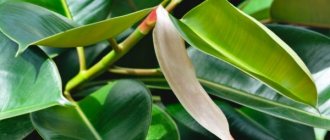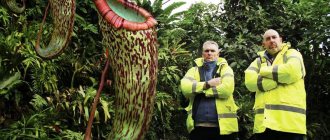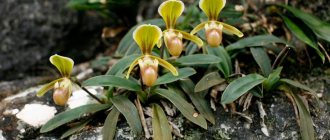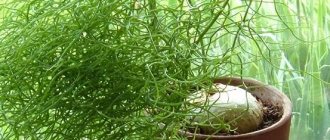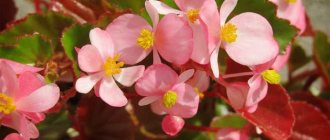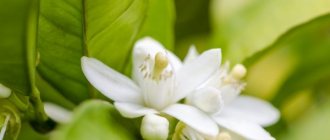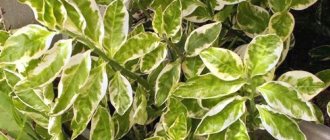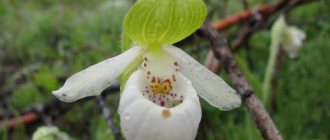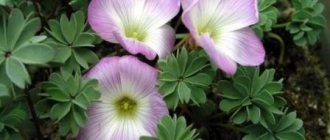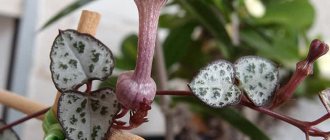The adiantum plant, also called adiantum, belongs to the genus of ferns of the monotypic family Pteris. This genus includes about 200 species. The name of such a plant consists of the prefix “a”, which is translated as “without-, not-”, and the second part of the name is translated from Greek as “wet” or “moisten”. As a result, the name of such a flower is translated as “not getting wet plant,” this is due to the fact that its foliage has the ability to repel water, so it does not get wet. This plant is most often found in the tropical regions of the South American Andes and East Asia. Adiantum prefers to grow on fertile, moist soil, which is typical of rocks in places located near waterfalls and springs. Adiantum was known to man already in the time of Pliny the Elder, who was the author of Natural History; he wrote about it in his works. Adiantum is the most popular among flower growers among all decorative ferns. It can be grown both at home and in a greenhouse. In addition to the fact that this plant has a spectacular appearance, it is also healing.
Brief description of cultivation
- Bloom . Grown as an ornamental foliage plant.
- Illumination . Shaded place (windows facing east and north are best).
- Temperature regime . In summer, no more than 22 degrees, and in winter - about 15 degrees.
- Watering . It is necessary to moisten the substrate in the pot systematically. In the warm season, this is done twice a week, and in the cold season - once every 7 days. It is recommended to water the fern using the bottom watering method; for this, the pot with the bush is immersed in a container filled with water.
- Air humidity . It should be increased. On hot days, it is recommended to moisten the foliage with a sprayer every day.
- Fertilizer . In April–September, the fern is fed with fertilizer for ornamental foliage plants in half the dose recommended by the manufacturer. In winter, fertilizing is not carried out.
- Rest period . In October–February.
- Transplant . On average, adiantum is replanted once every 2 or 3 years.
- Reproduction . By spores and division of the rhizome.
- Harmful insects . Scale insects, mealybugs, aphids and spider mites.
- Diseases . If you care for the fern incorrectly, it will lose its decorative effect.
- Properties . Fern has medicinal properties that are widely used in Chinese folk medicine and Western Europe.
General description of the plant
Even experienced gardeners note the grace and tenderness of this variety of ferns. Florists also did not deprive this flower of attention, using it to create a variety of compositions.
This fern is more suitable as an indoor flower rather than for decorating bouquets. The bottom line is that cut stems fade extremely quickly.
Leaves streaked with patterns look very attractive, and their bright colors will refresh any room and improve your mood on cloudy days. Adiantum is a perennial plant. Its height reaches 55−60 cm or more. The rhizome is very spreading and creeping.
Features of the adiantum
Adiantum fern is a perennial herbaceous plant, its rhizome is thin and creeping, it is covered with matte brown or black scales. The leaf blades can be alternate or opposite; they have dark glossy petioles that reach about 25 centimeters in length. The petioles at the base are covered with scales. Smooth and wide, highly dissected foliage is colored green or bluish. Its segments are fan-shaped, they have an obovate, wedge-shaped and trapezoidal shape. On the underside of the segments along the veins there are sori with sporangia of oblong, round or linear shape. The most commonly grown adiantum in the garden is the maidenhair, and at home the most commonly cultivated is the maidenhair called “Venus hair”, as well as the transparent maidenhair, Ruddy, tender, etc.
MAIDENHAIR. Everything about care - LIGHTING, WATERING, FERTILIZER, HUMIDITY, SOIL, PESTS and DISEASES.
How does adiantum reproduce?
Adiantum is propagated by dividing the rhizome during transplantation and by spores. Each method has positive and negative sides.
Root division
By dividing the root, only mature, or preferably old, ferns that have already begun to lose their decorative properties are propagated. Dividing the root is not such a harmless procedure. If the operation is unsuccessful you may lose the mother plant. And the survival rate of separated parts is not always high. The root of the adiantum is very sensitive, as is the whole plant.
- In spring, remove an adult adiantum bush from the pot.
- Clean the root system from the substrate.
- Using a sharpened sterile knife, cut the rhizome into pieces so that at least one leaf remains on each.
- Plant the parts in separate containers filled with light soil, sterilize it first.
- Spray the seedlings and moisten the soil.
- Place new plants in a shady and warm place.
- Apply foliar feeding through spraying.
- Adiantum seedlings develop slowly. Like adult ferns, they need high humidity, diffused light and warmth.
Young adiantums have taken root in new pots
Video: planting adiantum seedlings at home (master class)
Caring for adiantum at home
Illumination
When grown at home, adiantum reacts extremely negatively to direct sunlight. It grows well in partial shade; therefore, northern and eastern window sills are perfect for it. The fact is that due to excessively bright light, the lacy greenish foliage begins to die off.
Humidity and temperature
Indoor adiantum needs clean and fresh air, but it needs to be protected from drafts, and it also does not like dust. Therefore, the room where the flower stands must be systematically ventilated, and wet cleaning must also be done regularly. The air in the kitchen is very heavy for the fern, which can destroy it, and tobacco smoke can also harm it.
Make sure that during the warm season the temperature in the room is no higher than 22 degrees, as heat is detrimental to this plant. And in winter, it is recommended to move it to a cool place (about 15 degrees), located away from heating devices. Try to turn and rearrange the container with the flower as little as possible, as it reacts extremely negatively to this.
Adiantum needs high air humidity. To do this, on hot days, whether in summer or winter, it should be moistened with warm water from a spray bottle. However, when the room is too cold, it is better not to moisten the bush, because in this case this procedure can harm it.
Feeding
Fern feeding is carried out only in April–September. To do this, use liquid fertilizer for decorative deciduous indoor plants in half the dose recommended by the manufacturer (see instructions). Fertilizers are applied to the substrate once every 20 days. In winter, the plant is not fed.
Trimming
In order for the adiantum to always be attractive, it will need regular pruning, which is carried out in the spring. To do this, remove very old, limp leaves that have begun to turn yellow. If pruning is carried out in a timely manner, then the bush will spend its saved energy on forming new fronds. When the bush is pruned, it is moistened with a sprayer and watered.
Watering
Such a fern must be watered systematically and in a timely manner. Do not under any circumstances allow the earthen ball in the pot to dry out, as this may cause the foliage to dry out and die. If there is stagnation of water in the substrate, then rot may appear on the roots. To prevent uneven watering, bottom watering is used for ferns. To do this, the container with the bush is immersed in water, which should be filled with water; it should be well settled and at room temperature. You need to remove the pot only after the surface of the soil mixture in the container with the flower begins to glisten with water. Then the plant is transferred to the sink and wait until the excess liquid drains, and only after that it is transferred to a permanent place. In winter, the frequency of watering should be reduced, but the substrate will need to be moistened in the same way. On average, in summer you need to moisten the soil twice every 7 days, and in the cold season - once a week.
Adiantum transplant
This fern is characterized by very slow growth, and also by the fact that it prefers to grow in a cramped container. In this regard, it is transplanted only when roots appear from the drainage holes. On average, transplantation is carried out once every 2 or 3 years in the spring. If the bush is old, then instead of replanting it, the top layer of soil mixture in the pot with a thickness of 50 to 70 mm is changed every year.
Fern has a very powerful root system; therefore, to grow it, it is recommended to choose a wide pot made of wood or ceramic (unglazed on the inside); there should be large holes at the bottom for drainage. A good drainage layer must be made at the bottom of the container. A suitable substrate should be loose and acidic, as well as saturated with humus; the composition can be as follows: 1 part leaf soil and 2 parts peat. The drainage layer is covered with a thin layer of soil mixture, after which the plant is carefully transferred into the pot. Carefully fill all the voids with a new soil mixture, but there is no need to compact it too much, since the roots should be in a loose substrate.
Maidenhair. Transfer. [Hope and Peace]
Conditions for Venus hair
All the beauty of the adiantum is the beautiful fronds with the contrast of dark, slightly wavy petioles and soft green small leaves. But Venus's hair is fragile. Fronds will not grow well if there is not enough space for the maidenhair. Do not place the fern in a close group of flowers, give it more space to develop, and then its beauty will remain for many years.
Adiantum is not very capricious, but still requires certain conditions, without which it will not be able to show all its beauty. In order for the green hair to be lush and bright, provide it with high air humidity and warmth, diffused light, without hot sun, do not overheat the plant and do not allow the soil to dry out. The best place for adiantum is an eastern or northern window. You can place it in the west and even on the south side, but then move the plant three meters deep into the room.
Table: conditions for adiantum
| Spring | Lighting: partial shade, diffused light. Possibly some sun in the morning and evening. Humidity is high 60–70 percent or more. Regularly spray the adiantum with lukewarm water, use other methods of moisturizing (more on this below). Provide fresh air, ventilate the room. The temperature is moderate, about 20–25 degrees. |
| Summer | Lighting - partial shade, diffused light, a small amount of sun is permissible only in the morning and evening hours. Shade the plant at midday. Humidity is high 60–70 percent or more. Spray the plant often, give it a shower, but cover the soil with film. The temperature is moderate, preferably up to 25 degrees, maximum 27. Heat is difficult to tolerate. On hot days, ventilate the room, but keep it away from drafts. Walking is only possible in places protected from the wind. It can damage delicate leaves. And keep in mind that adiantum does not like changing places. |
| Autumn | Diffused lighting, partial shade. Humidity is high. Temperature is moderate. |
| Winter | Lighting - partial shade, diffused light, possibly a small amount of sun. No additional lighting is needed. Humidity is high. Moisten the leaves and air. Place the maidenhair tree away from heating devices and cover it with a protective screen. Temperature is moderately cool + 15–22 degrees. It cannot stand below +10 degrees. Protect the adiantum from drafts. |
How to humidify the air for delicate adiantum
In nature, adiantum grows along the banks of reservoirs, and it especially likes waterfalls. The plant needs high humidity all year round - this is perhaps the main difficulty for the gardener. Dry air is detrimental to the delicate green hair of Venus. There are simple ways to create a tropical atmosphere at home.
- The apartment also has its own waterfalls - taps. Place the adiantum in a room where the air is especially humid. For example, in the kitchen (only at a distance from the hob and oven) or the bathroom, if there is a window there.
- Give the adiantum an indoor fountain. This way you will kill two birds with one stone: you will make the composition with ferns more decorative and humidify the air.
- Place an electric humidifier next to the adiantum.
- Spray the fern with the smallest spray bottle. Use lukewarm water. In winter, spray in the first half of the day so that the leaves have time to dry before evening. In summer, do not spray at midday; droplets of water in the sun can cause burns.
- Place the adiantum next to the same moisture-loving plants. Then after spraying the moisture will remain longer.
- Have a maiden shower at least once a week. During water procedures, especially in the cold season, cover the ground with a film or bag to prevent waterlogging.
- Place the maidenhair pot on a large tray with pebbles or expanded clay. Keep the litter moist at all times.
- Place the adiantum in a double pot. Place the container where the fern grows in a waterproof pot filled with sphagnum moss or peat. Moisturize them regularly. Excess moisture, evaporating from the second pot, will maintain air humidity around the adiantum.
Adiantum reacts quite quickly to too dry air. Its leaves turn yellow, first the tips dry out, and then the entire leaf blade dies. How to help a fern and restore its beauty? If the problem has just appeared, remove dead fronds and use various methods of air humidification. Most likely, the adiantum will recover. If the fern has lost almost all its leaves, also try to save it. Cut all damaged leaves to the ground. Provide the adiantum with cool (+18–20) content and high humidity, water moderately. The root retains its vitality for a long time. The fern will respond to good care with new growth.
Video: conditions and care for adiantum
Reproduction methods
Dividing the bush
In indoor conditions, adiantum can be propagated by dividing the rhizome. During spring replanting, an adult, overgrown bush is pulled out of the pot. It is divided into several parts using a very sharp instrument. At the cuttings, the cut sites are sprinkled with coal powder, after which they are planted in individual pots. Before dividing the bush, inspect it. If it has few growing points, then the plant is not suitable for division, since as a result of this procedure it may die.
The planted cuttings take root for quite a long time and only then begin to grow. Before cutting the rhizome into pieces, wait until the lump of soil in the pot dries thoroughly. And when planting cuttings in separate pots, make sure that the root collar is not too deeply buried in the substrate, otherwise rot may appear on the shoots
Growing from seeds
Adiantum can also be propagated indoors by spores. To do this, take a low container and fill it with a soil mixture consisting of sand, peat and leaf soil (1:2:1). Compact the substrate and pour freshly boiled water over it. When it becomes cool, spread the spores evenly on its surface, cover the crops on top with film (glass) and transfer them to a warm and dark place. Before sowing, spores for disinfection are moistened from a sprayer with a weak solution of potassium manganese. In order for seedlings to appear as quickly as possible, the crops will need lower heating to 21 degrees. The first shoots may appear either after 1 week or after 3 months. When this happens, the cover is removed from the container, and the crops are moved to a well-lit place, protected from direct rays of the sun. The grown plants dive into a larger container, keeping a distance of 25 mm between them. But it’s better to immediately plant them, 2-3 at a time, in individual containers filled with peat soil.
Replanting the maidenhair
In the wild, adiantum prefers rocky river banks and hangs out in crevices near waterfalls. It doesn't need much soil. The root of the fern is superficial, so a shallow and wide pot is suitable for growing, and the drainage layer should be impressive. The maidenhair will like the soil to be slightly acidic, nutritious and porous; it should absorb water well and dry out quickly. You can take ready-made soil for ferns, adding a little charcoal and chopped sphagnum moss to it. Or make your own potting soil. Approximate compositions:
- Add part of leaf and humus soil and half part of sand to 2 parts of peat soil.
- 3 parts each of peat and leaf soil, 2 parts of turf soil, 1 part each of humus or vermicompost and sand.
- Mix 3 parts of leaf soil with 2 parts of peat soil, 1 part of humus and coarse sand.
- Mix turf soil, peat and coarse sand in equal parts.
- In equal parts leaf soil, pine bark, humus and coconut fibers.
Young ferns need annual replanting in spring. An adult adiantum is replanted when the roots fill the entire pot. Often this procedure is combined with propagation; the overgrown root can be divided. How to transplant adiantum?
- Take a suitable container with holes, place drainage (expanded clay, pebbles, broken brick) at the bottom. Everything needs to be disinfected, at least doused with boiling water.
- Spread sterilized soil on top. Don't compact it too hard; it should remain airy.
- Remove the maidenhair from the old pot. Inspect the roots. Remove rotten, darkened and dry ones.
- Try not to damage healthy roots; there is no need to trim them. The fern root system grows slowly.
- Place the earthen ball with the adiantum in a new pot. Add some soil. Lightly compact the substrate at the roots. Remember: ferns like loose soil.
- After transplanting, water the plant with warm water and spray it.
- Place the transplanted adiantum in a permanent place.
Diseases and pests
Pests
Adiantum foliage contains substances that repel pests. But today, some insects are able to quickly adapt to various poisons, even very strong ones. In this regard, scale insects, aphids, mealybugs and spider mites can settle on the plant.
If scale insects are found on the bush, then they need to be removed from it with a brush or a cotton swab moistened with alcohol. Aphids are combated by treating the plant with a soap solution, which must be washed off from the foliage. And if the aphids still remain, then treatment is carried out using a solution of Inta-vir, Derris, Antitlin, Actellik, Decis, Biotlin or Fitoverm. To get rid of mealybugs, the bush must be sprayed with a special insecticidal preparation, for example: Confidant, Antitlin, Aktara, Biotlin, Confidor, Fitoverm or Mospilan. If spider mites are found, then treatment with Fitoverm or Actellik will be required.
Diseases
Adiantum is very resistant to diseases, however, if it is not cared for correctly, this can negatively affect its decorative properties. For example, due to poor watering or when gas is burned near the plant, its foliage begins to dry out and turn brown at the edges. Flying leaves indicate that the air in the room is excessively dry. In this regard, it is necessary to moisten and water the bush regularly and in a timely manner.
If the leaves of a bush become faded, this means that the place where it stands is lit too intensely. Therefore, move the pot to a darker place. If the foliage of the adiantum curls, but does not dry out, then this is a sign that the room has excessively high humidity and too low an air temperature.
Possible problems
- The shoots dry out, the tips of the leaves dry out - low air humidity, hot.
- Pale, limp leaves - soil overflow at low temperatures. Rot may appear on the root system.
- all the foliage has dried out at elevated temperatures in the room in winter , the adiantum should be moved to a cool room (18–20 degrees) and systematically moisten the ground. New leaves may form if the roots survive.
- The leaves turn pale, turn yellow and dry out - they are exposed to direct rays of the sun.
- The foliage turns yellow en masse - too little watering or the flower needs feeding.
Transplantation and propagation
Maidenhair plant is perfect for growing in open ground with a mild climate. It independently reproduces by spores and with the help of creeping rhizomes. Indoor species of young ferns are replanted every spring, and adult plants only in cases where the root system fills the entire pot. Often this procedure is combined with dividing the plant.
Transplantation and transplantation features
Ferns are transplanted in the spring, before active growth. For indoor species, it is advisable to choose a wide and shallow pot, since their root system is superficial. Place drainage at the bottom of the pot, which can also be replaced with pebbles or broken bricks. You can buy ready-made soil or make it yourself. The composition of the soil may include: leaf or turf soil, pine bark, peat, coconut fibers, coarse sand or perlite, humus or vermicompost. Sphagnum moss and charcoal are added to maintain moisture to prevent rot. The resulting mixture must be sterilized in the oven or poured with boiling water.
Adiantum propagation
Adiantum can be propagated by dividing the bush or by spores. Reproduction by dividing the rhizome will help rejuvenate an overgrown adult plant that has lost its decorative effect. The procedure will allow you to quickly obtain ready-made plants. Due to the fact that the plants are quite delicate, there is a high risk that the flower will not take root. In spring, adult ferns are removed from the pot, the rhizome is cleaned and dry old roots are removed. Using a sharp and sterile knife, the rhizome is divided into parts. Each root segment must have a bud with leaves. The cut site must be treated with activated carbon or another antiseptic. The resulting young plants are planted in separate containers with light and sterile soil. For better rooting, cuttings can be immersed in Kornevin solution before planting. The finished seedlings are placed in a warm, humid room or greenhouse, shaded from direct sunlight.
Growing young plants with spores requires more time and preparation. The optimal temperature is +22 degrees, constant high humidity is required. Mature spores collected from a large leaf are distributed into sterile soil evenly over the surface. Lightly sprinkled with soil, moisten the spores and cover them with glass or film. The room should have a stable temperature of +22...+25 degrees and minimal lighting. It may take 3 months before the first shoots appear. After germination, the film is removed and the seedlings are transferred to a lighted room. The seedlings are thinned out, leaving large and healthy specimens. For good development, the distance between them should be at least 3 cm. After just a month, the young plants are ready for planting in separate pots; you can also plant several plants in one pot.
Properties of adiantum
The composition of adiantum foliage includes triterpenoids, flavonoids, lipids, steroids, phenolcarboxylic acids and their derivatives, as well as essential oil. In Western Europe, infusions, medicinal powders and syrups, and preparation from the leaf plates of such a plant are widely used. Syrups and infusions are used as a remedy that has an antipyretic and expectorant effect, and the aqueous extract has antimicrobial properties.
Products made from adiantum are used for diseases of the liver, respiratory tract, bladder and spleen. The juice obtained from the leaves is used to make compresses and lotions against rabid animal bites for detoxification purposes, as well as in the treatment of malignant ulcers. In Chinese medicine, a decoction is prepared from the leaves of adiantum, which helps in the treatment of alcohol addiction.
To reduce the amount of dandruff, it is recommended to rinse your hair with a decoction of adiantum leaves or you can add the juice of this plant to the water. In the treatment of psoriasis, an alcoholic tincture of adiantum is used.
Adiantum (Venus Hair). Why Ferns Dry Out. Answer to Subscriber Question
A little history
More than 200 years ago, the Venus hair flower (photo presented in the article) settled in a person’s home. Florists immediately appreciated the elegance of the openwork leaves (their name is fronds). In those days, this plant, delicate and sensitive to air quality, could not adapt to simple huts with stove heating. Adiantum and other types of ferns were grown only in winter gardens and greenhouses of wealthy families.
Central heating improved the quality of the atmosphere in apartments, so these flowers began to decorate the premises of a variety of houses. However, this was not without problems: the dry air of apartments with central heating negatively affected the health of the fern. Today there are many ways to create the humidity necessary for a plant, so wonderful adiantum is bred at home without much hassle.
Types of adiantum with photos and names
Adiantum "Venus hair" (Adiantum capillus-veneris)
Under natural conditions, the species can be found in the mountains of Crimea and the Caucasus, as well as in Central Asia. It prefers to grow on wet limestone rocks near water sources. Its thin rhizomes are painted black. The species received this name due to the fact that on long petioles (about 25 centimeters) delicate and light fan-shaped leaf plates of a greenish color grow. As a rule, the species is cultivated at home.
Adiantum pedatum
This species is one of the most beautiful ferns. An openwork plant, distinguished by its elegance, can be found in the deciduous forests of North America and East Asia. The height of the bush is about 0.6 m. Its foliage is glossy, one-sided, flat, greenish in color, it is pinnately dissected and notched along the edge. The leaf blades are arranged horizontally on thin glossy petioles. The species is characterized by very high frost resistance; it can withstand temperatures down to minus 35 degrees. The most popular varieties:
- Compactum - bush height about 0.35 m;
- Imbricatum - this dwarf variety reaches only about 15 centimeters in height;
- Aleuticum - this variety is only about 10–12 centimeters high, but can reach a width of 15 to 20 centimeters; most often it is grown in a pot, since it tolerates bright sunlight better than other ferns;
- Japonicum - a young bush has shoots of a copper-pink hue, but over time they turn green, the height of the bush is up to 0.45 m, and its diameter reaches about 0.3 m.
Tender maidenhair (Adiantum tenerum)
Under natural conditions, the species can be found in the tropical regions of America and on the Greater and Lesser Antilles. The creeping rhizome of the bush is quite short. The three-pinnate leaf plates are wedge-shaped at the base, and broadly serrated along the upper edge. The foliage is about half a meter wide and up to 0.7 m long; it grows on long petioles (about 0.3 m). The best varieties:
- Farleyens - the foliage of the bush is very impressively curled;
- Scutum Roseum - young foliage can reach a height of 0.3 m, it has a variable color from green to pinkish.
Adiantum hispidulum
In nature, the species prefers to grow along the snow line of the African mountains, and it is also found in Australia, Madagascar, India and New Zealand. The rhizome of the bush is creeping, the shape of the leaves is palm-dissected, they are covered with small bristles, and their length varies from 15 to 25 centimeters. The foliage is located on petioles about 0.35 m long. The diamond-shaped leaves of the second order are about 5 mm wide and up to 20 mm long, both of their surfaces are covered with small bristles. In indoor conditions the view looks very impressive.
Adiantum raddianum
Or wedge-shaped (Adiantum cuneatum). This epiphyte is native to subtropical Brazilian forests. The length of the gracefully curved leaf plates is about 0.45 m, and their width is up to 0.25 m. The foliage is dissected into numerous rich green leaves, which are located on glossy black petioles. Popular varieties:
- Grasillium and Micropinnulum - these varieties have finely dissected foliage and are highly demanding of high humidity, so they are recommended to be cultivated in florariums;
- Fritz Lut and Festum - these varieties are more resistant to unfavorable conditions, and therefore they can be cultivated at home.
Adiantum caudatum
The species is grown as a hanging plant, since its foliage reaches a length of about 0.6 m. The leaf petioles are brown in color, and there are suckers at the tops of the leaves. This species reacts extremely negatively to drying out of a clod of earth in a pot.
Beautiful adiantum (Adiantum formosum)
The height of this bush is about 100 cm, its rhizome is very fragile. The multi-pinnate leaves are located on black-violet petioles. The dark green segments of the leaf blades have a triangular-obovate shape.
Charming adiantum (Adiantum venustum)
In nature, the species can be found in Kashmir and Nepal. Narrow greenish leaf plates reach about 20 centimeters in length, and they are located on purple-black petioles. The foliage segments are slightly pointed. If the bush is exposed to low temperatures, its foliage will turn pale brown.
Adiantum cuneatum
The species is similar to the beautiful adiantum, but its sori are shaped like a horseshoe. He is originally from the South of Brazil.
Adiantum diaphanum
The height of the bush varies from 0.25 to 0.4 m. The pinnate leaf blades at the base are double-pinnate. The length of the fronds is about 20 centimeters, and the width is up to 3 centimeters; they are located on thin long (about 20 centimeters) petioles. The greenish segments of the leaf blades are bare and broadly oval in shape.
Adiantum fragrans
This species is very popular among gardeners. Under natural conditions, it is found in southern Asia and the South American Andes, where it forms dense bushes. This delicate fern is characterized by rapid growth, reaching a height of about half a meter. The length of the greenish oval leaf plates is about 30 mm, and the width is up to 15 mm; they are located on very long petioles (from 10 to 15 centimeters).
Indoor adiantum, care, reproduction and types
Among the huge family of ferns, the graceful indoor adiantum, also known as Venus hair, is popular among gardeners.
Representatives of the genus can be found in South America, New Zealand, Madagascar, and Africa, where they grow in tropical rainforests and coastal areas, so the key factor in caring for adiantum at home is high air humidity.
Most species are characterized by thin drooping petioles strewn with small, delicate emerald leaves arranged in a fan-shape. Spores ripen on the underside of the leaf blade.
The underground part is a rhizome that develops horizontally. On its surface you can see growth buds from which new shoots are born.
Fern leaves have the interesting property of repelling water when it rains, which is why the name of the genus Adiantum is translated from Greek as “waterproof plant.”
Signs and superstitions associated with adiantum
Since ferns existed on earth long before the appearance of man, the plant is of interest. Numerous folk signs and superstitions that have survived to this day tell us what changes can occur in life when meeting it in nature or when breeding it at home.
Another important feature of fern is that it is a magnet for financial flows.
Those wishing to improve their financial situation are recommended to have an adiantum in their apartment. In addition to money, the miracle plant also attracts good luck. That is why gamblers love it so much. There is a legend that if you find a fern flower on the night of Ivan Kupala, any wish will come true.
Watering
The main rule of watering is moderation and regularity. The plant has a negative attitude towards both waterlogging and overdrying. Therefore, you should water it little and often. In the spring-summer period - three times a week, in the fall - less often, and in winter - once every 7-10 days. Make sure that the top layer of soil dries out between waterings.
It should be remembered that Venus hair does not tolerate chlorinated water. It is best to use settled and filtered water.
Adiantum propagation
This is one of the easiest plants to propagate, which takes root quite well when divided and makes it possible to obtain healthy, highly ornamental plants even from relatively small parts.
Before the separation procedure, the earthen lump of fern is dried almost completely. The division is carried out manually, if possible without cutting, studying the growth points and leaving a sufficient number of roots on the divisions (the minimum parts for separation should have 2-3 fronds).
In the spring, when transplanting, you can divide the mother bush.
After division, care is similar to a regular transplant, but the plants will require careful observation and careful moistening for longer, since maidenhairs may not show signs of beginning to grow and adapt for several months.
Adiantums can also be grown from spores. Sowing is carried out in a peat substrate common to ferns, superficially, after drying, and in as thin a layer as possible. Sowing of spores is carried out in small bowls and with lower heating. Under glass or film, in the shade, at an air temperature of 24 degrees Celsius and a constant level of humidity, spores can germinate in 5-6 weeks.
The glass or film is removed immediately after the sprouts appear, moving the plants to diffused bright light. Seedlings will need thinning; they are transferred to individual containers only after active growth begins and a height of 3-4 cm is reached.
Origin and distribution
Adiantum, or Lady's hair, is rightfully one of the most graceful ferns. According to legend, it appeared from a hair of Venus, the goddess of love and beauty, thrown to the ground.
And it is no coincidence that this fragile-looking plant is compared to the hair of a goddess: its foliage, indeed, looks like a lush girl’s hair
This plant belongs to the Pteris family (ferns), one of the oldest on Earth. Its ancestors appeared 400 million years ago, in the Paleozoic, but some of them are still found on the South American continent, representing giant fern-like trees. The diversity of species is widely represented on the globe, especially in the subtropical and tropical zones.
Adiantum can be found both in Western Europe and at the foot of the mountains of North Africa and Central Asia. In Russia, this plant feels good on the Crimean Peninsula and the Caucasus.
Most often it can be seen in shaded places along rivers, lakes, streams - where moisture seeps through the nutrient soil.
Adiantum easily colonizes rocky shores thanks to its well-developed powerful rhizome
The fern is a spreading, creeping herbaceous plant with beautiful, carved leaves. Their distinctive feature is the repulsion of water: when watering, it flows in streams without wetting the leaf plate. Because of this unusual property, the fern got its name Adiantum (from the Greek “a” - not, “diaino” - to wet).
Individual leaf segments, often fan-shaped, do not exceed 2–3 cm in length
This airy, delicate fern is not so delicate: it is quite hardy and undemanding at home.
Reproduction
All types of Adiantum reproduce by spores or division of the bush.
Seeds (spores)
To grow ferns from spores, you need trays with low sides. They are filled with a substrate consisting of:
- peat land,
- sand,
- leaf humus, at the rate of (1:0.5:0.5).
The substrate is compacted and filled with boiling water. Excess moisture should drain through the drainage holes. As soon as the soil has cooled to room temperature, distribute the seeds on the surface of the soil. Cover the plantings with film or glass and place in a warm place. It is advisable to treat the seeds with slightly diluted potassium permanganate .
You can speed up the germination of crops. To do this, you need to heat the bottom of the container. Seeds usually germinate within a week, but this process can take up to 2 months.
When the seedlings become strong, they need to be planted in 2 plants in separate pots. You can pick them out into a large box at intervals of 3 centimeters.
Dividing the root
Only an adult adiantum bush needs to be divided. It is better to do this in early spring during the next replanting. Separate the bush with your hands, being careful not to damage the growing points . If there are no additional growth points or there are few of them, it is better not to divide such a bush. This will lead to the death of the plant. You need to be patient, because new plantings take a long time to take root.
Diseases, pests and problems in growing adiantum
In the wrong conditions, especially in very dry air, maidenhairs often attract pests. It is difficult to combat them with simple washing, so if symptoms of spider mite or aphid infestation appear, it is better to immediately begin treating with insecticides.
Treatment with a soap solution helps against many pests.
Adiantums often signal problems themselves. Withered leaves call for more intensive watering, curled leaves call for reducing watering or controlling the air temperature. Falling and drying of leaves is always associated with sunlight, high temperatures and dry air.
Economic importance and application
Ornamental plant.
In the Caucasus, or leaves, they wash their hair to give it shine.
Medicinal use
The above-ground part of the plant is used for weaning. In 1962, the drug Tosiphron was proposed, consisting of flavaspidic acid obtained from the leaves of this fern. It is produced in the form of tablets, suppositories, drops - it is effective in treating addiction to tobacco and strong coffee.
, infusion, decoction, (independently and in combination) is used as an emollient, expectorant for respiratory diseases, and antipyretic.
The leaves are included in some Western European countries.
In Indian medicine (raw materials - in the form of a paste) are used for healing wounds, juice (mixed with) - for respiratory infections, as a tonic. B as hemostatic. In medieval medicine, it was used for, chronic, retention, juice (topically) for malignant diseases, as a detoxifier for rabid dog bites, ointment (topically) for eye diseases, . In Bulgaria, a decoction is used for coughs, especially in children, a decoction, an ointment - as a collection - for hyperkeratosis of the scalp; In South Africa, people smoke for respiratory infections.
Water exhibits antibacterial activity.
A decoction, infusion, or liquid extract is used as an ingredient that improves the taste of syrups.
In folk medicine, powder, infusion (on its own, in collections) - (diuretic properties were not found in the experiment), choleretic, laxative, for, decoction, syrup - for, diaphoretic, stimulant, for diseases, tumors of the spleen and; promoting hair growth.
How to propagate adiantums
It's a simple and fun process. Adiantum can be divided by rhizome at the beginning of the summer season. The cuttings are placed in separate pots and await growth. Usually this takes a long time. Be sure to treat the cut areas with activated carbon, otherwise the cuttings will die from rot.
Spores form on the underside of the leaves of the adiantum, which can be propagated by them. For pecking, you need nutritious peat-based soil and a temperature of exactly 21 degrees Celsius. Make a mini-greenhouse and lower heating of the soil - if possible, it won’t be superfluous.
Germination of spores
Before planting, you need to prepare the soil and the spores themselves. Pour soil into a low, wide container, compact it a little and pour boiling water over it. They do this to eliminate pathogenic fungi and bacteria. The spores are placed for some time in a weak solution of potassium permanganate, which increases the resistance of future sprouts to negative environmental influences.
Step-by-step instructions for planting adiantum seeds:
- The spores are evenly scattered in the box. There is no need to dig them in, as this will make the germination process longer and reduce the chance of hatching.
- A film is stretched over the container, thereby achieving a greenhouse effect. Once every few days, the film is opened to spray and ventilate the soil.
- The box with seeds is placed in a warm and bright place. It may take time for seedlings to emerge. In some cases, sprouts appear within 2 weeks, sometimes it takes more than a month.
- After the sprouts appear, remove the film and place the container in a well-lit place (not under direct rays).
Grown strong seedlings can be moved to a pot in a permanent place.
Dividing the bush
It is best to propagate the maidenhair fern by dividing the rhizomes in the spring. To do this, remove the lump of earth from the flower pot and carefully examine the rhizome. It is important to check for rot and damage. If they are found, the bad parts of the roots are cut off with a sharp knife.
In addition, you need to pay attention to the number of growth points. If there are not enough of them on the mother bush, the plant should not be divided. There is a high risk that the flower will not take root.
Immediately after dividing the bush, the roots in the cut areas need to be treated with charcoal. Then all the divisions are planted in prepared pots with soil.
Botanical description
Genus of ferns Adiantum, a specimen of the monotypic family Adianthaceae. It got its name from the Greek symbol α, meaning negation - not, without. And the word “διαινειν” is translated as - to moisturize. Droplets of water do not stick to the leaves of the plant; they quickly roll off, leaving them dry . Hence the associations in the name of the fern.
Among lovers of indoor floriculture, Adiantum “Venus Hair” is more popular. In total, there are more than 198 species in the genus of ferns.
In the wild, this plant can be seen in North America, Africa, India, China, mountainous regions of Asia and subtropical regions of Europe.
Adiantum usually grows in rock crevices, on the shore of a reservoir. It is ranked among the most elegant, beautiful types of ferns. Possessing a delicate, fragile appearance, the plant is very hardy, but it also requires attention and careful care in cultivation. At home, adiantum is often grown in a hanging form. This type of fern does not tolerate tobacco smoke, drafts and dust . It is advisable not to place it in the kitchen, because gas combustion products are quite harmful to the plant.
Fern has medicinal properties; it is recognized as a pharmacopoeial plant in some European countries. An aqueous extract from adiantum has an antibacterial effect. Other forms of medicinal fern - powder, tincture, syrup and other preparations act as an emollient, expectorant, and antipyretic.
Adiantum - the most graceful fern
Adiantum is a bright representative of the glorious and numerous family of ferns. In the wild, it usually lives in the lower tiers of tropical and subtropical mountain forests. But the adiantum has also mastered the mild temperate climate. It tolerates slight frosts, but in cold weather the above-ground part of the fern dies off. It can be seen in the North Caucasus, Crimea, Mediterranean, European countries, America and the mountains of Africa. Adiantum has a predilection for mountainous terrain, shady and damp places. It is able to grow on rocky soil and does not need much soil. This fern settles on the banks of rivers, near waterfalls, and in rock crevices.
Adiantum prefers mountainous terrain, shade and humidity
More than two hundred years ago, the maidenhair fern moved into human habitation. Flower growers immediately appreciated the grace of its patterned leaves (they are called fronds). However, the delicate plant, sensitive to air quality, was not then able to fully adapt to homes with stove heating. Therefore, adiantum, like other ferns, was grown only in rich families who had greenhouses and winter gardens. Central heating improved the atmosphere in apartments, and maidenhairs decorated window sills in a variety of houses. But a new problem has appeared: too dry air in heated apartments is harmful to the health of ferns. Now there are different ways to make the humidity higher. This means that now fans of the wonderful greenery of adiantum can grow this exotic plant without much hassle. Moreover, according to doctors and cosmetologists, humidified air is also beneficial for humans.
The name maidenhair comes from the Greek expression a diant, which means “not to wet.” The surface of the leaves of this fern seems to be covered with a film. Water flows off them without stopping, that is, without wetting them.
Adiantum has light leaves on dark petioles
Adiantum is the most elegant among ferns that are grown at home. He received the name Venus Hair. But this is the name of only one species. There are other, less well-known, but equally picturesque varieties. Adiantum differs from the classic fern, with a rosette of long drooping leaves in an arch, by special petioles, black and reminiscent of thin wire. Apparently, these petioles inspired the comparison with hair. Why the hair of Venus? Because this goddess, born from sea foam, is the embodiment of love and beauty. Who else but her could wear such an elegant hairstyle? After all, the hair-stalks are decorated with soft green small wavy leaves, so similar to curly curls. At the edge of each leaf there is a sorus, this is a kind of pocket in which fern spores ripen.
There are several legends about the origin of adiantum. A beautiful young girl fell from a cliff. A waterfall broke through in this place, and her hair became a fern. Another legend says that Venus, the goddess of love, cut her hair and dropped a strand, and from it a maidenhair tree grew. That's why it was called Venus hair.
Adiantum is not the tallest fern. Usually its leaves do not grow longer than 40–60 cm. But it grows very quickly. The rosette can double in size over the spring and summer. Therefore, when choosing a place for adiantum, you need to take into account its growth rate. And make sure in advance that there is room for him. The fact is that the adiantum has a slight whim. He is constant and does not like to be moved from place to place. Due to stress, a lush head of foliage can lose its decorative effect and even dry out. So it is better to immediately assign it to a permanent place.
Try to immediately determine a permanent place for the adiantum; it does not like moving
Adiantum is mentioned in the works of Pliny the Elder, an ancient Roman writer. Ancient healers, noticing the similarity of the foliage of this fern with curls, recommended the plant as a remedy for hair. Some peoples of the Caucasus still rinse their hair with adiantum infusion; it is believed that it adds shine. In China, a decoction of the leaves is used in the treatment of alcohol and tobacco addiction. Adiantum will force you to adopt healthy habits. It is like a typical, but also especially delicate fern, very sensitive to dirty air. Therefore, it does not tolerate smokers. Tobacco or other smoke is harmful to adiantum.
The delicate greenery of the adiantum will require some attention from the gardener. But by creating this fern the conditions to which it is accustomed, by indulging its whims, you will get wonderful patterned emerald green fronds. They will decorate such corners of your home where no plant would agree to grow. Adiantum will not require artificial lighting in winter. He is content with partial shade in the back of the room or near the north window. Adiantum is beautiful just on the windowsill, on a high stand or in a hanging pot.
Adiantum: a popular indoor fern
The airy lace of the most common maidenhair fern seems weightless. They are so different in appearance from the austere and elegant common garden ferns that the plant is not easily recognized by everyone as their closest relative. Adiantum is so popular that it is firmly entrenched in the lists of the most unpretentious crops. In fact, it is quite capricious, but even inexperienced gardeners can grow it. The main thing is to remember that this is a forest and tropical plant and provide it with appropriate care.
Maidenhair: a popular indoor fern.
Care
Venus hair, like other varieties, requires certain care.
- The plant does not tolerate any movement very well, so the pot should always remain in one place.
- To improve the condition of the plant in summer, it must be actively (daily) sprayed with warm water.
- In winter, the plant does not need water treatments, as they can have a detrimental effect on its development.
- In the spring-summer period, it is advisable to carry out scheduled fertilizing with liquid fertilizers (reduce the concentration indicated in the instructions by 2 times). This should be done no more than once every 3 weeks. In winter, fertilizing is not needed.
Venus hair is a flower whose care includes pruning damaged and yellowed leaves. This must be done in the spring to make the plant tidy. This process also stimulates the appearance of new, young leaves. After removing the old greenery, the plant should be well watered and sprayed.
